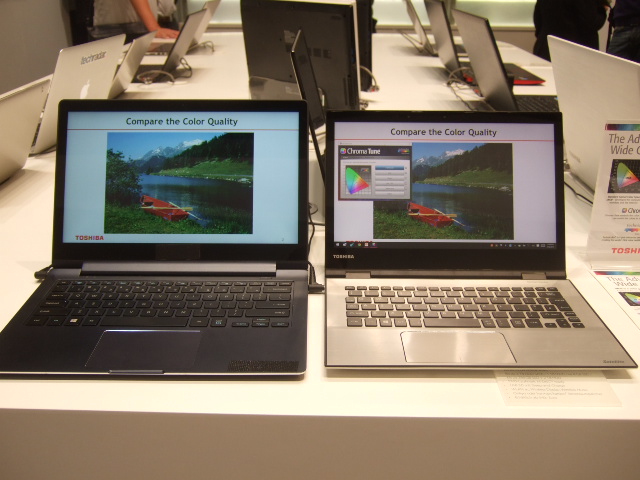We were kept busy at the Toshiba stand for at least an hour and a half last year, but the 2015 booth was much more compact. Toshiba had moved from Hall 22 to Hall 12: a smaller space that it shares with Razer, Acer and Wacom.
Since IFA 2014, Toshiba has moved away from TVs in the European market, where it has licensed the brand to Compal (Toshiba to Partner with Compal on TVs in Europe). We still expected to see some products – after all, Philips still shows TVs, despite the range being managed by TPV – but instead Toshiba was firmly focused on notebooks. There were no Toshiba sets at the show, as far as we could tell.
That is not to say that we didn’t see anything interesting. Toshiba had three new products, one of which – the Satellite Radius 12 – uses a very premium display. It is a 12.5″ convertible PC, with a 360º hinge enabling the display to revolve to lie flat against the rear of the keyboard. While a standard Full HD unit will be available in October (£710 ($1,085)), Toshiba is also producing a model with UltraHD resolution (£835 ($1,275)). In addition, Technicolor’s Chroma Tune colour processing is built in.
The Radius 12 has a touchscreen and runs Windows 10 on Intel’s new Skylake processor platform (Core i5 or i7). It features HDMI, USB 3.0 (x2) and USB-C ports, with storage between 128GB and 512GB (SSD). The display uses an IPS panel, with 400 cd/m² of brightness and Gorilla Glass NBT protection.
We had a chance to go ‘behind the scenes’ and talk to Martin Fishman of Portrait Displays, which developed the Chroma Tune product with Technicolor. The Satellite Radius 12 is the first notebook to be Technicolor Colour Certified and features a wide colour gamut: 100% Adobe RGB, as well as sRGB and Rec.709 (we believe it uses a Sharp IGZO panel). Technicolor is now certifying using all three colour spaces, rather than only sRGB, because common content is created using all three. Portrait told us that as well as the Technicolor setting, other settings could be certified where there is a public standard. i.e. Adobe RGB, sRGB and Rec 709 are “Technicolor certified” whereas the Toshiba Warm and Cool settings are not certified.
Toshiba was not discussing the technology behind the expanded gamut on the Radius 12, but did reveal that it is hardware-based, rather than software. Compared to a competitor’s product, with a panel covering 60% NTSC (the Radius 12 covers 98%), the difference was stunning. All colours looked much more accurate at the standard setting, and very vibrant using Adobe colour.
Chroma Tune also supports automatic switching of gamuts by application. For example, the user can set up an automatic switch to AdobeRGB when the focus is on Photoshop, or Rec 709 for video editing. That makes it much more likely that the feature will be really used.

After the Radius 12 we saw the 14″ Satellite Radius 14 notebook, which also features the 360º hinge. This is a more mass-market product, with 1366 x 768 resolution, HDD or SSD options and Skylake or AMD processors. Prices start at £375 ($570)).
The final new product was an addition to the Click Mini range of detachable tablets. The Satellite Click 10 has a 10.1″ display (and, we noticed, a very large inner bezel), with 1920 x 1080 resolution and an IPS panel. This is joined by 2GB of RAM and 32GB of storage, although this is expandable via an SD card slot.
Micro-USB and HDMI outputs are featured on the tablet, with the keyboard docking station adding two additional USB ports. With the extra battery in the dock, the Click 10 will last for 15 hours on a single charge. The product will cost £235 ($360)).
All of Toshiba’s new products run Windows 10 and are ‘Windows 10 optimised’; this means that they feature dual-array microphones and a dedicated Cortana button. They will be launched in October.
All prices are ex VAT.

